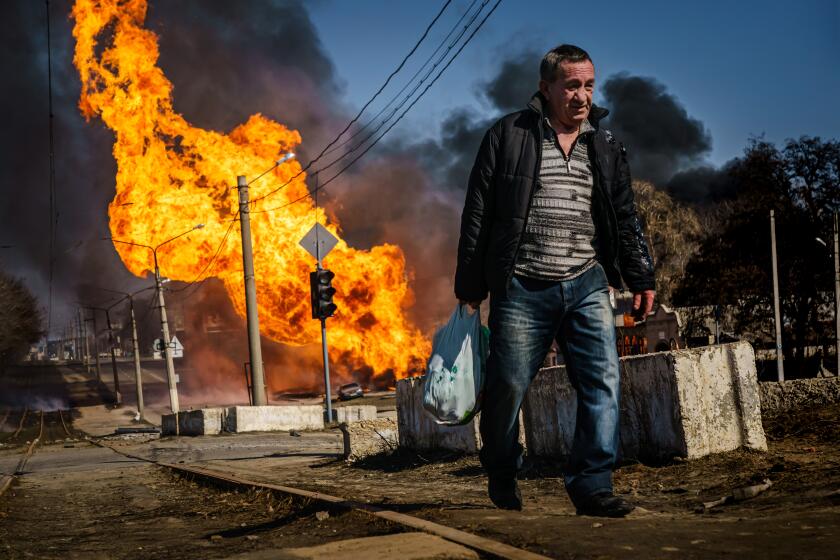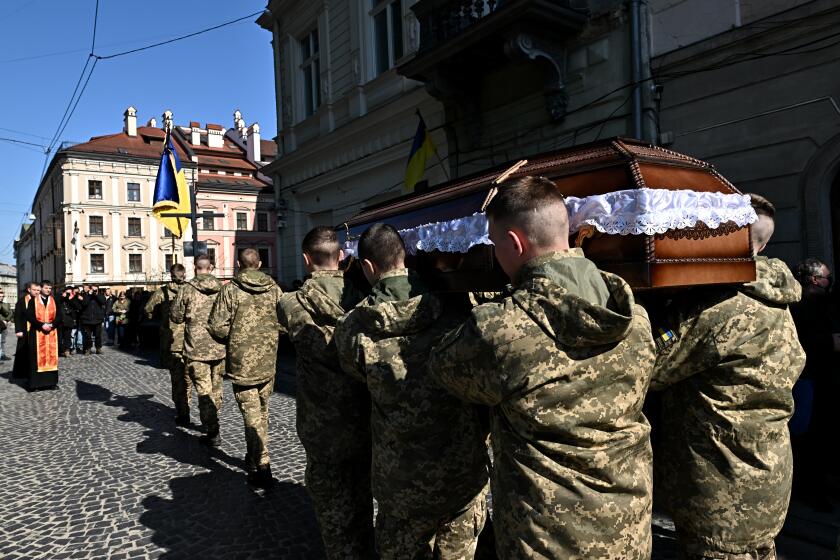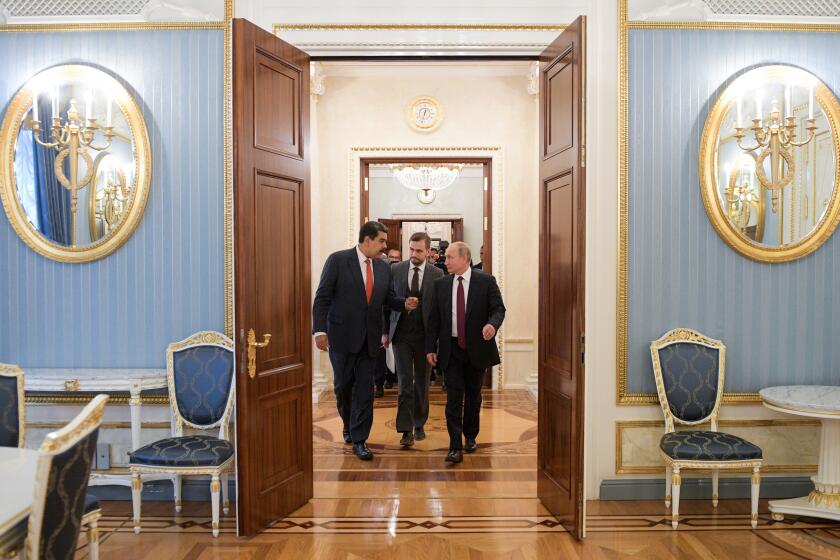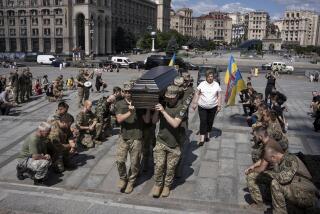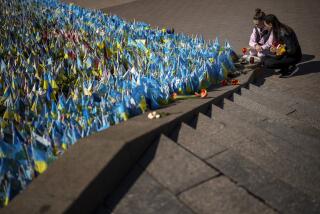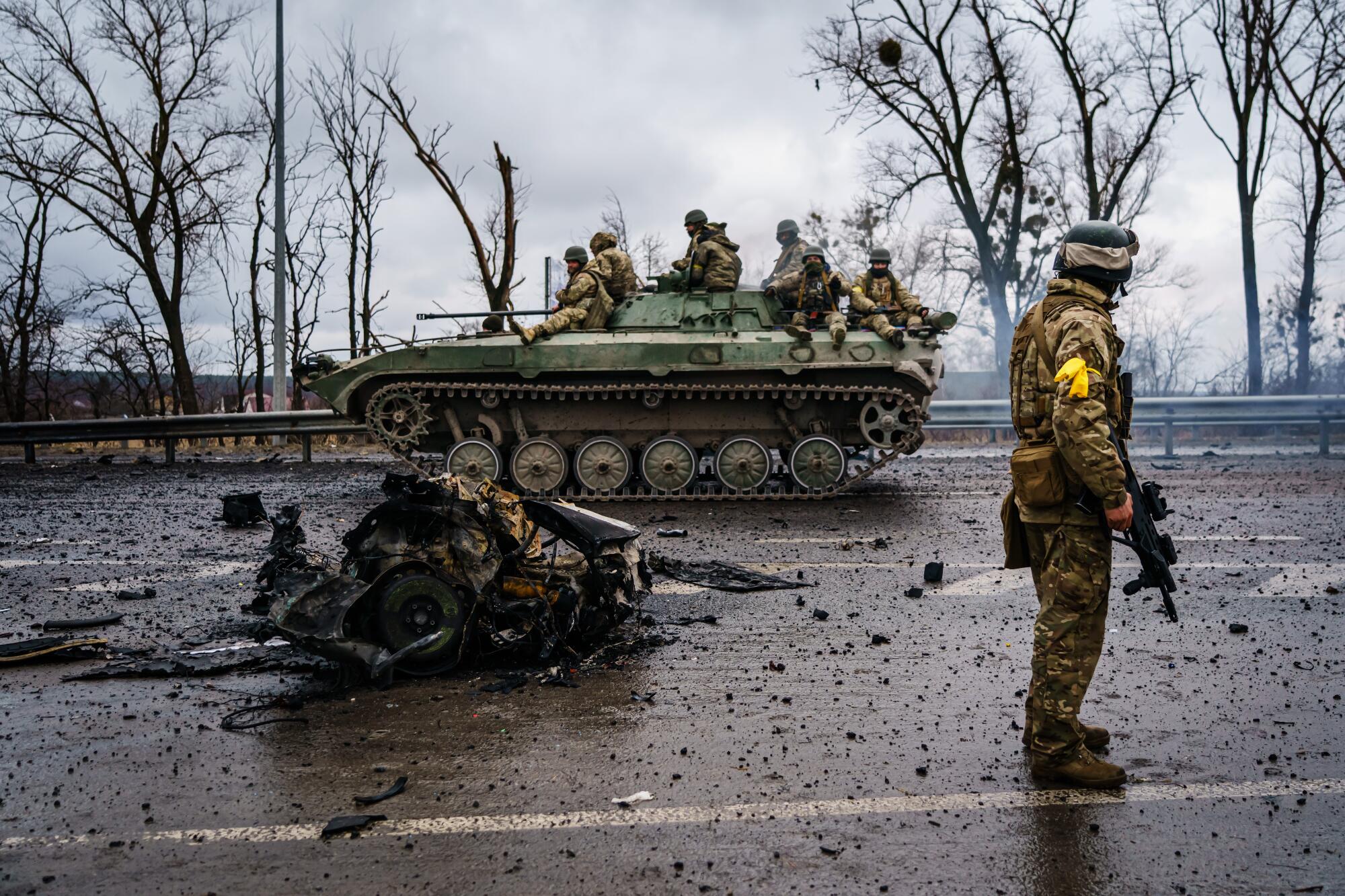
- Share via
SYTNYAKY, Ukraine — The shell that reamed the Russian soldiers’ vehicle scattered them in all directions. One was face down on the asphalt, arms outstretched. Another was a mass of white and red in barely-there fatigues. Heat had singed the skin of the third, and the fourth had been thrown 130 feet, landing in a field by the road, torso mangled, legs twisted backward.
The fight between Ukrainian and Russian forces — it had been a three-vehicle group, including an armored personnel carrier and a Ural truck — erupted on E40, an 8,000-mile trans-European highway that threads its way from France’s Calais to Kazakhstan, passing through this spot near a roadside hotel. It’s a 24-mile straight shot to the capital, Kyiv.
The battle ended Thursday morning. The cleanup began in the afternoon: A soldier directed traffic around bits of flesh, bone and metal; a tank jerkily hauled a burnt-out armored personnel carrier down the highway; men off to the side unloaded a truckload of large caltrops. Nobody touched the corpses.
This is Ukraine now. Eight years of fighting over the country’s breakaway Russian-backed eastern region have morphed into a vicious war for its existence. Kyiv is virtually encircled. Kharkiv, Ukraine’s second-largest city, suffers a daily pummeling from shells and missiles. Swaths of the nation’s south have already fallen into Russian hands, as have parts of the east. A nuclear plant has been attacked; Russian shells rain on civilians, many of whom now sleep by the thousands in basements and subways.
More than 1 million have been turned into refugees. There are fewer safe places. The Ukrainian winter has shown signs of spring, but snow still falls through columns of smoke and over graves hurriedly dug.
A 500-mile drive through the country to outrun the start of the Russian blitz — from Shchastia in the disputed Donbas region to Kharkiv and back to the capital — underscores not only the challenges facing Moscow’s onslaught, but also the cost to Ukrainians grappling with the wounds of what for years had been called a “frozen conflict” before it exploded last month and startled the world.
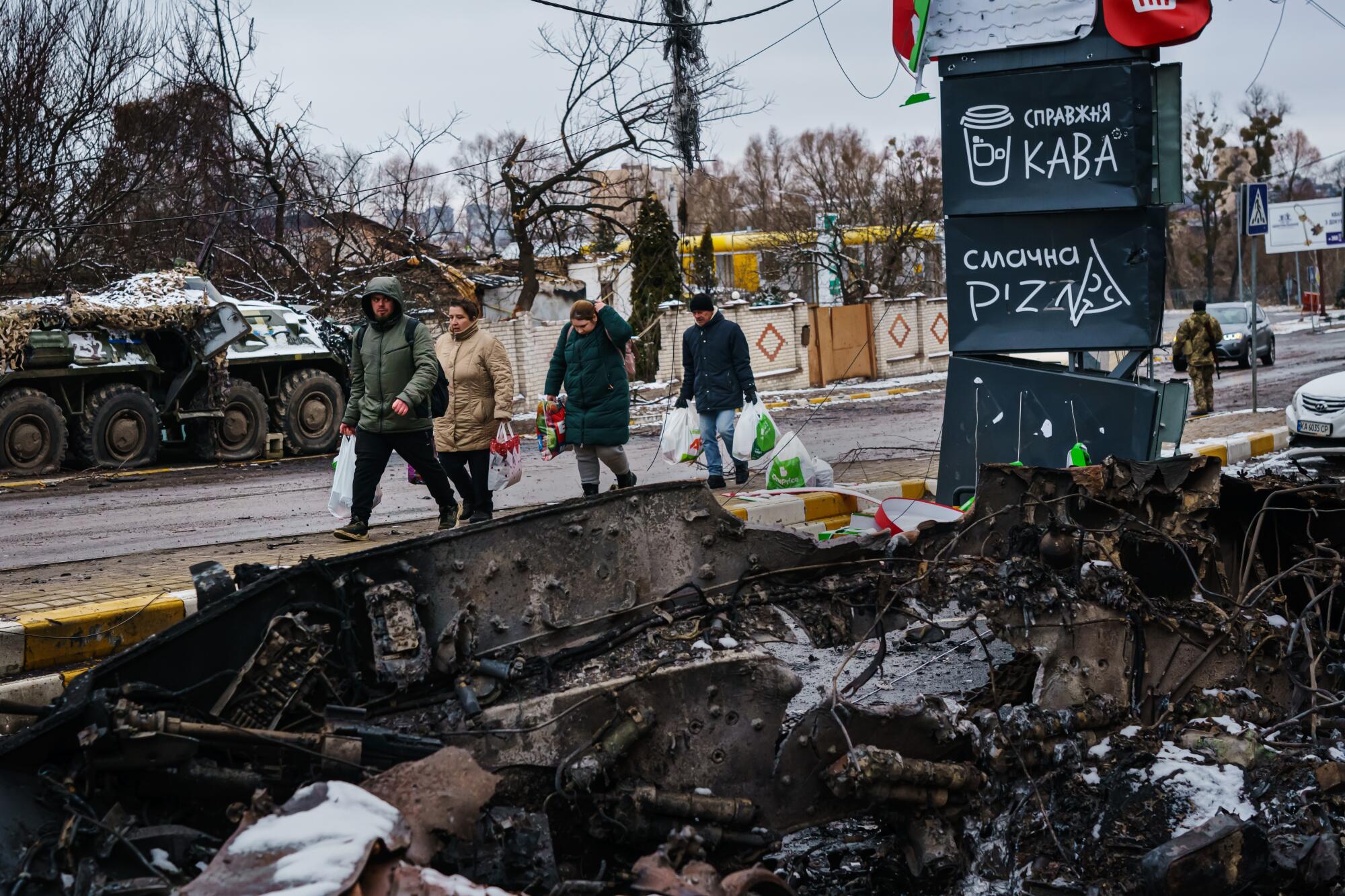
The most obvious expression of those wounds had been in eastern Ukraine. Driving through its towns and villages, one finds roads that just end.
Go down a street, take a turn and there’s a roadblock, a full-on security barrier or a checkpoint with stern soldiers admitting no passage. Beyond, just a few miles and a growing political chasm away, are the so-called Donetsk and Luhansk people’s republics.
The two breakaway states that Russian-backed separatists created in 2014 — and now the ostensible reason for Moscow’s war on Ukraine — amputated two-thirds of the two provinces (informally known as the Donbas region) from the country. Since then, Tania Nikolayevna, a pensioner in her 60s, has reckoned with that loss.
Before the war, she lived in Luhansk city, barely 10 miles away in Shchastia, where like many of the provincial capital’s residents she would come to her family-owned dacha. In 2014 it became her permanent home. What was once a 15-minute jaunt became an hours-long trek, a passage Nikolayevna didn’t do so much anymore. She hadn’t visited her grandmother’s grave back in Luhansk for two years.
Wearing a red jacket and a white wool cap that framed her face, she stood with her husband — in gray overalls, an ill-fitting down olive jacket and fine-dotted black-and-white cap — queueing by a well, where residents moved a lever to pump water into plastic jugs. Such rituals had become a way of life.
This was last month, back in the “will he or won’t he” phase of Russian President Vladimir Putin’s plan to blitz into Ukraine with an estimated 190,000 troops. Those who thought he would invade surmised that he would satisfy himself with the declared borders of the Donetsk and Luhansk people’s republics.
A cease-fire in two southern Ukrainian cities meant to allow civilians to evacuate fell apart amid new Russian shelling, officials say.
Shchastia was in the crosshairs. But Nikolayevna wouldn’t go.
“Of course we’re worried,” she said. “But I’m afraid to leave because I have nothing.”
Like many pensioners, she remembered better times, when this part of the nation was the industrial engine of Ukraine. The Donetsk and Luhansk oblasts cover some 9% of the country, but the war held 16% of the population in dense urbanized areas. Many of them grow around sprawling industrial projects such as the Luhansk power station. But fighting crept in, and things changed. An errant separatist shell had sheared some power lines and damaged it, authorities said, disrupting electricity and water pumping stations.
Young men had mostly vanished from these towns, seeking opportunity elsewhere after the war had denuded this area of economic life. For pensioners like Nikolayevna, the best years were during the Soviet era. She reluctantly acknowledged that if the Russians came, it would perhaps be easier: She would be able to visit her Luhansk city again, its memory giving her voice a softer tone.
“It was beautiful: gorgeous parks, squares. But I also liked to walk in the forest,” she said. Now she was too afraid to go off-track “because of mines.”
And it didn’t matter to her if a person spoke Ukrainian or Russian, a division that had become almost a marker of loyalty. Most people in Shchastia spoke Russian, but Nikolayevna also “wished to hear Ukrainian.”
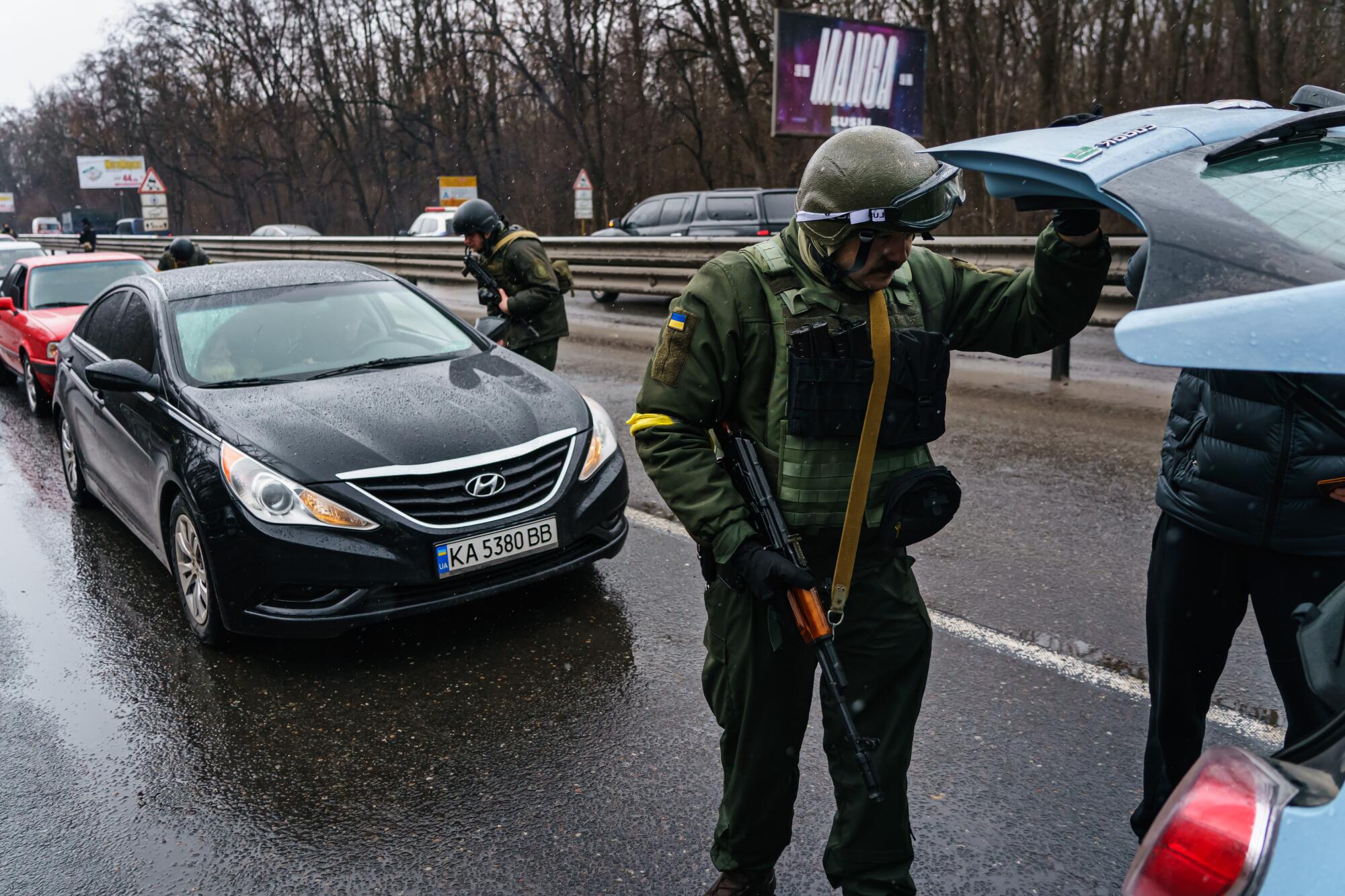
“I don’t want these parts to be separated,” she said, trudging a bit lopsided from the jugs.
“We don’t care about money or salaries. All we care about is peace.”
But a fresh war came on the cold morning of Feb. 24. Shchastia, once a crossing into the Luhansk People’s Republic, was subsumed by the Russians on the first day of the offensive. Some who escaped sought sanctuary in Kharkiv, thinking that Ukraine’s second largest city, less than two dozen miles from the northern border with Russia, would hold special meaning for Moscow.
The Times’ Marcus Yam, no stranger to war photography, gives a first-person account from Ukraine.
After all, they calculated, the bonds with Russia run deep: The city is largely Russian-speaking, and many have relatives across the border. Historically, Kharkiv was the capital of Soviet Ukraine. When the pro-European protests ousted Ukrainian President Viktor Yanukovich in 2014, there were celebrations in Kyiv, but many in Kharkiv saw it as a coup. At one point, it was thought separatists would try to establish another pro-Russian breakaway enclave there.
Those bonds were tested but not broken after the 2014 war. Many spoke of relatives on the other side. They resented Kyiv’s dictates on using Ukrainian and demonizing the Russian language, feeling that the government was cutting another link with those they called brothers.
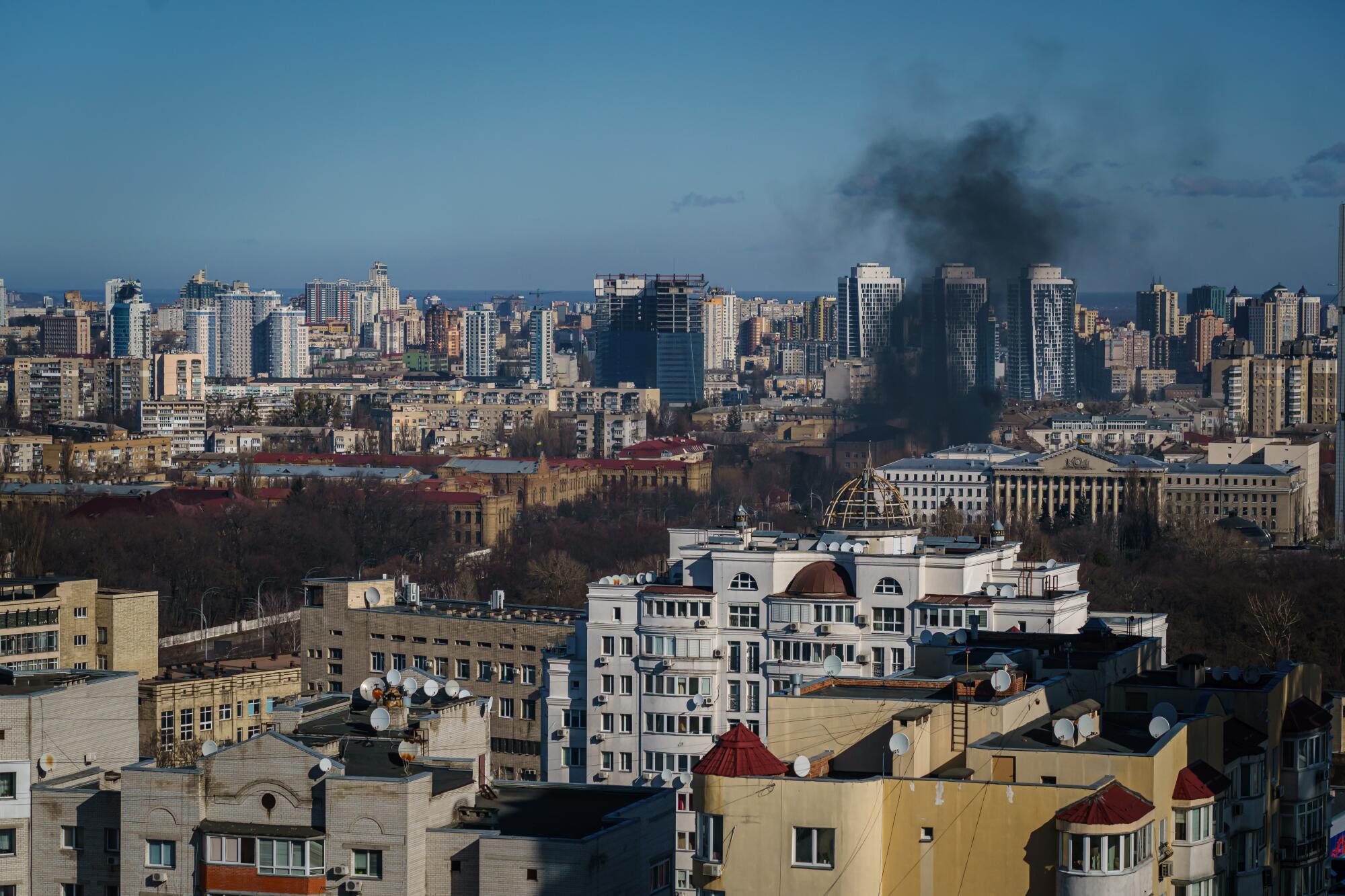
But none of it mattered to Moscow. In recent days, Russia fired missiles into Kharkiv’s elegant squares and ornate government buildings, in scenes many said were reminiscent of the city’s 1941 fight against the Nazis. The ferocious Russian attacks perplexed Alexander, a 41-year-old martial-arts instructor from Kharkiv who gave only his first name for reasons of privacy.
“It’s as if it was to persuade a city, which was close to them, that they are invaders and aggressors,” he said.
Alexander spent six days in a shelter with his family before braving his way out of the city 20 minutes before an airstrike. Passing through the checkpoints, he spoke Ukrainian, a language he’s less comfortable with than Russian.
“I responded in Ukrainian to avoid any problems,” he said.
“Sure, we’d switch back after that to Russian, but it’s like a system, to determine if you’re friend or foe.”
Alexander would navigate a dangerous new world, and with news of Kharkiv being surrounded, others raced toward Kyiv. Somehow, the internet was still working. Google Maps showed a do-not-pass sign on a few highways, but there still was a way out.
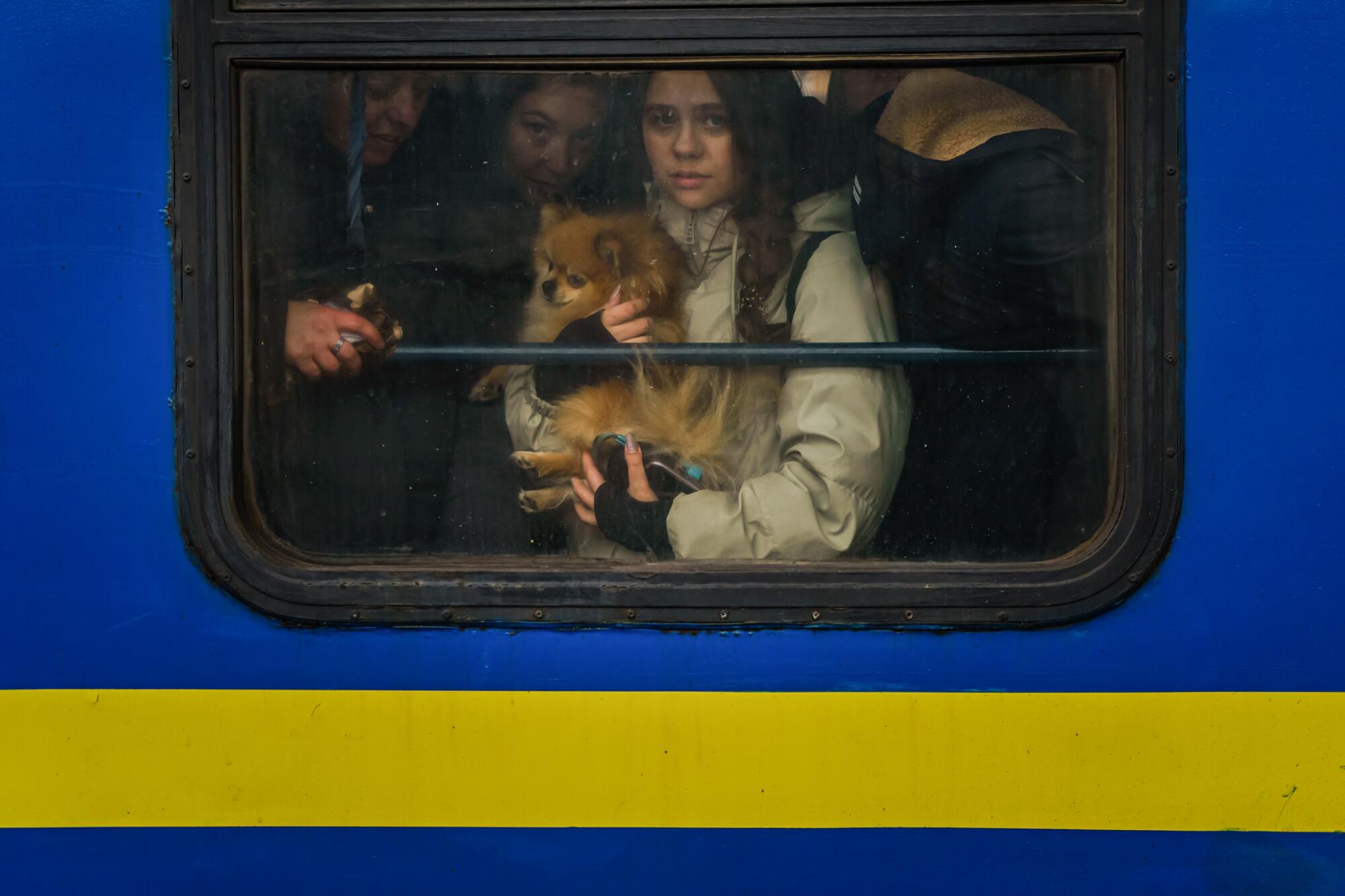
It took hours, a dash through highways and pothole-scarred backroads that, when night fell, were illuminated only by a dim lamp at a checkpoint or the blaze of the Russian military truck torn in two by Ukrainian forces, a fire crackling out of its center.
Entering Kyiv, the highways were deserted. Cars sprinted nervously, with any distant explosion turbo-charging drivers to greater speeds.
For months, Kyiv, a city of gold domes and a grand past bisected by the Dnieper River, found itself in the eye of a geopolitical storm. The cliche is that the storm is calmest at its center, and Kyiv had shown that, right up to the first day of the invasion.
The Friday before it was, well, Friday night in a shabby but hip capital full of hip bars and hip restaurants now crammed with hordes of not-so-hip journalists quaffing hip-but-tasty cocktails alongside hip-looking Kyivites.
Almost 800,000 Ukrainians have fled to Poland as Russian forces push farther into Ukraine.
Yes, they had trained in the Territorial Defense Force, and yes, they had prepared the guns. But people enjoyed a night out. Then the invasion began; rifles were handed out to all who were able, and homemade bombs were bottled. And now with a Russian convoy dozens of miles long waiting 18 miles away, what has the capital become? A waypoint on a desperate scramble? A city on borrowed time? A trap-filled fortress with an army and ready-insurgents, its boulevards a trap-filled gantlet promising death to all who pass unpermitted?
Either way, curfews descended. The war hadn’t fully entered Kyiv; it still remained calmest inside the storm.
Instead, the violence was intense at the periphery, near the Ukrainian soldiers stationed on E40 and in Makariv, a village of 10,000 people a few miles closer to Kyiv. On Wednesday, the Ukrainians clawed it back from Russian control, but only just — it remained surrounded on all sides, said Julia, an English teacher for children now turned interpreter at checkpoints.
Venezuela, Cuba and Nicaragua — all long-standing allies of Russia — have voiced support for the Russian leader.
The 27-year-old said Ukrainian troops had forced back part of a Russian column to the nearby fields and forests.
“They’re panicking. It was a very long column, lots of tanks. Our army stopped them and they’re now around our city,” she said to a sporadic snare-drum of cannon and artillery fire in the background.
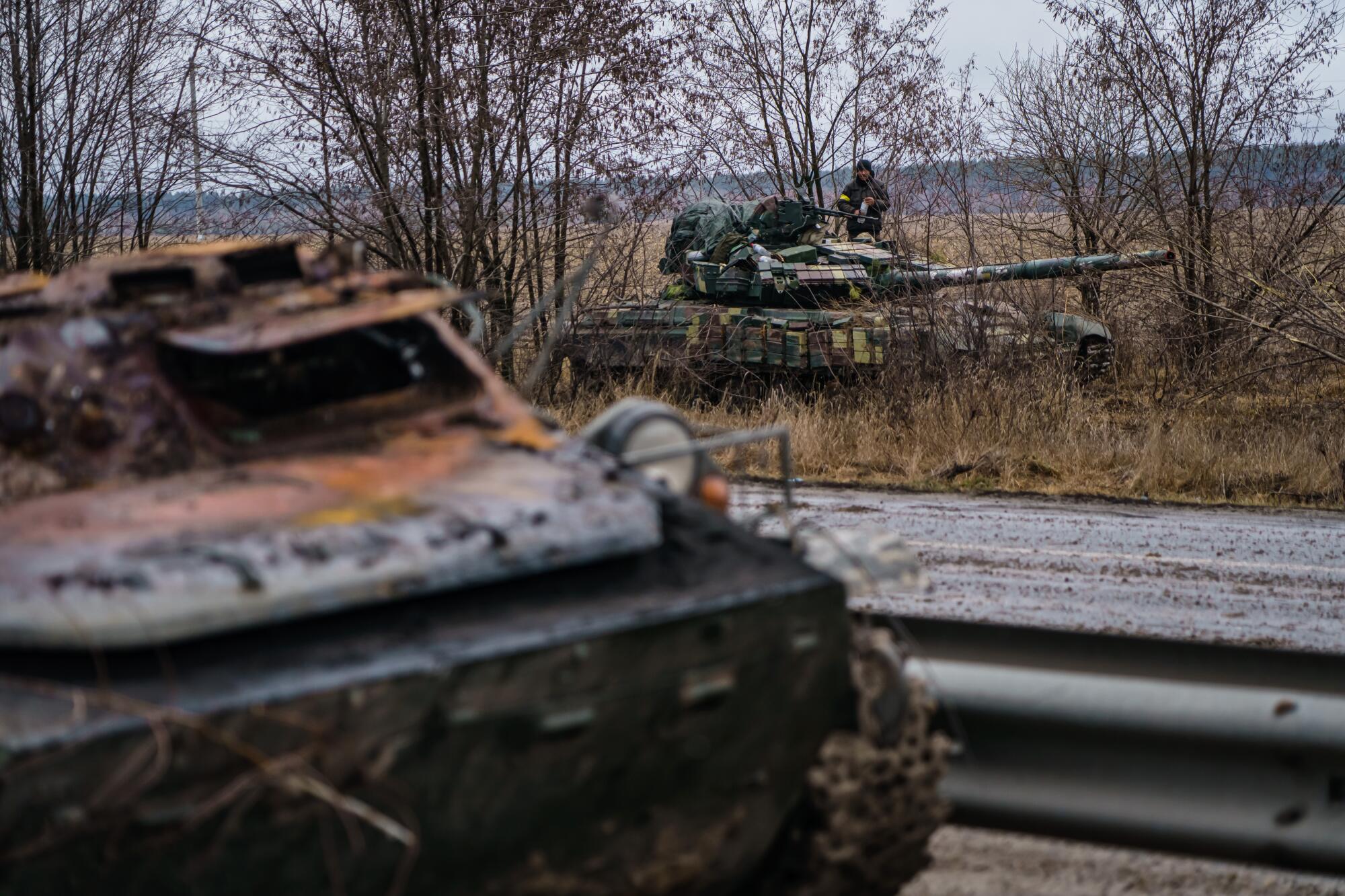
Many others said they were determined to protect their homes. But Julia, who gave only her first name for reasons of safety, gave a simpler reason why she and her husband were still in Makariv: “We didn’t have time.”
She was terrified, especially at night. But everyone left in the village was working to repel the Russians. That included a man nicknamed Malina, an old pensioner in an ancient-looking brown camouflage outfit, a toothless grin and bright-but-sad blue eyes. They didn’t seem anywhere near enough to face the firepower behind them.
“We’re pushing them back,” Julia said, “because this is another way to Kyiv.”
Not far away, and days later, the dead Russian soldiers lay in the cold, a hint of snow in the air. A battle had come and gone. More were in the offing. The sounds no one wants to hear were moving closer. A bit farther up the road lay a heart without a body. It was unclear from which soldier it had come.
More to Read
Sign up for Essential California
The most important California stories and recommendations in your inbox every morning.
You may occasionally receive promotional content from the Los Angeles Times.

